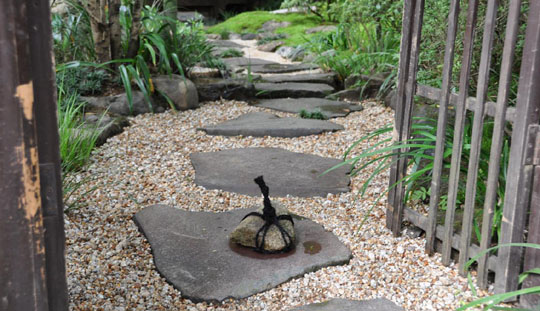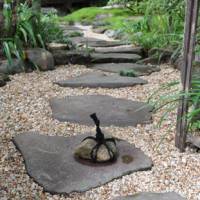Dear Alice,
Recently I toured a beautiful traditional garden in Kyoto with a Japanese friend. At a fork in the path, I was about to turn to the right when my friend stopped me and said we were not supposed to go that way. I did as she said, but couldn't understand how she knew. She'd never been there before, and there was no sign or gate. When it happened again, I asked her to explain. She pointed to a rock tied in twine, sitting atop a stepping stone, and claimed that means "no entry." How the heck can that be? And is this something all Japanese people know?
Miranda T., Nishinomiya, Hyogo Prefecture
Dear Miranda, You were duly diverted by a tome ishi (stop stone) or, to use its more descriptive name, a sekimori ishi (boundary-guard stone). It is a device used in Japanese gardens, particularly those with tea houses, to guide visitors along a prescribed route. You occasionally see them elsewhere, such as outside a traditional restaurant to indicate it's closed, but these whimsical wrong-way markers are most strongly associated with tea gardens.
In legend, at least, sekimori ishi are linked to the great tea master Sen no Rikyu (1522-1591). The story, as recorded in a renowned tea tome called the "Nanporoku," is that Rikyu once invited a famous Zen priest to call. But before the priest arrived, Rikyu placed a little pot in front of the door, wordlessly and playfully challenging his visitor to find a way in without crossing this symbolic barrier.
No one knows whether Rikyu really did this, given that the story was recorded a full century after his death. And no one knows who decided to use a stone instead of a pot. But one way or another, the convention developed in tea circles of marking boundaries with a tied-up stone. Even today, part of the preparation for a tea ceremony is to set out these stones, not only to guide guests to the tea house but also to express the host's desire to help guests follow the correct spiritual path.
You asked whether this is something all Japanese know. "Definitely not," according to Takayuki Shimizu, a landscape architect who first became interested in sekimori ishi when instructed to construct one as part of his licensing exam.
"People who practice the tea ceremony know about them. And so do people interested in traditional gardens," he said. "Otherwise, most Japanese haven't a clue."
Hoping to raise consciousness about an underappreciated nugget of Japanese culture, Shimizu created a Web site to share his musings and research.
"One of the mysteries about sekimori ishi is: When did rope come to be used, and why?" he told me when I went to visit his workshop. "Of course, the rope makes the stone easier to notice, and to move from place to place. But ever since ancient times, Japanese people have used rope to mark off sacred space and designate things as divine. I believe the presence and authority in a sekimori ishii comes largely from the fact that it's bound in rope."
It's not particularly difficult to make a sekimori ishi. All you need is a rock and rough black gardening twine such as warabinawa (made from ferns) or shuronawa (made from palm hemp).The tie is the same cross you'd use to ribbon a birthday present, with a decorative tuft at the top, although Shimizu adds a harness of flat knots along the bottom so the rock will sit more stably.
The hard part, according to Shimizu, is finding the right rock. "I spend a lot of time at stone-vendors, searching for just the right shape," he said.
A good rock, he explained, is flat on the bottom so it sits well, but with a pleasing rounded form above. It should be large enough to be noticed, but not so big that it's difficult to move around.
I'm charmed by the concept of a hard object as such a "soft" barrier. If you think about it, a little rock isn't going to keep out anyone determined to get in. You could step right over it, if you were so inclined. The magic of these rocks is that they work by tacit agreement, an understanding between host and guest, in the same way a "wall" made of paper provides privacy just because everyone agrees to pretend sounds won't pass through.
That softness is what inspired a pair of architects to take this tea-ceremony concept and apply it to a knotty urban problem. If you've ever walked along the underground passage between the West Exit of Shinjuku Station and the Tokyo Metropolitan government headquarters, you may have noticed the odd parade of green and yellow stumps that line much of the walkway. There are several hundred of the protuberances, and while the Tokyo government calls them "street art," it's likely that the underlying purpose is to prevent homeless people from lodging along the walls.
Offended by such cold objects in a public space, Osamu Fujimori, associate professor at Tokai University in Ashihikawa, Hokkaido, and fellow architect Hiroyuki Matsushima borrowed from traditional culture to propose a less aggressive alternative. Their idea, shown at the 2007 Tokyo Designers Week show, is to replace the stumps with a modern interpretation of sekimori ishi. They created illuminated boundary stones by molding hard, translucent plastic into rocklike shapes and lighting them from inside. To finish off the design, they wrapped the rocks with rope.
"Signs with strong wording such as 'tachiiri kinshi' ('No trespassing') are ugly and overly assertive," Fujimori told me. "A traditional boundary stone, on the other hand, conveys information in the form of a request, not an order. It says, 'koko ni hairu no o goenryo kudasai' ('Please refrain from entering here'). That's a much gentler message, and one we'd like to see used in design more often."
I know it's only rock 'n' rope, but I like it.
Puzzled by something you've seen? Send a description, or better yet a photo, with the address where you saw it to [email protected] or Alice Gordenker, A&E Dept., The Japan Times, 4-5-4 Shibaura, Minato-ku, Tokyo 108-8071




